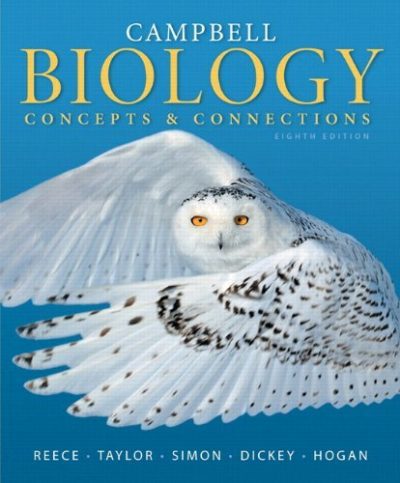In Stock
Test Bank Campbell Biology Concepts Connections 8th Edition Reece Taylor
Digital item No Waiting Time Instant DownloadISBN-10: 0321946685 ISBN-13: 978-0321946683Edition 8th EditionAuthor ReecePublisher Pearson
Original price was: $55.00.$20.00Current price is: $20.00.
Test Bank Campbell Biology Concepts Connections 8th Edition Reece Taylor
Campbell Biology: Concepts and Connections, 8e (Reece et al.) Chapter 1 Biology: Exploring Life1.1 Multiple-Choice Questions1) Which of the following statements about the properties of life is false? A) Organisms have the ability to take in energy and use it.B) Organisms have the ability to respond to stimuli from the environment. C) Organisms have the ability to reproduce.D) Organisms have an unchanging, constant internal environment Answer: DTopic: 1.1Skill: Knowledge/ComprehensionLearning Outcome: 1.22) Life is organized in a hierarchical fashion. Which of the following sequences correctly lists that hierarchy from least inclusive to most inclusive?A) ecosystem, population, organ system, cell, community, molecule, organ, organism, organelle, tissueB) cell, molecule, organ system, organ, organelle, population, tissue, organism, ecosystem, communityC) molecule, cell, organism, organ system, tissue, population, organ, organelle, community, ecosystemD) molecule, organelle, cell, tissue, organ, organ system, organism, population, community, ecosystemAnswer: DTopic: 1.2Skill: Application/Analysis Learning Outcome: 1.3 Global LO: 23) What is the difference between a tissue and an organ system?A) The tissue level of organization is more inclusive than the organ system level.B) Tissues are not composed of cells; organ systems are composed of cells.C) A tissue cannot exist unless it is a component of an organ system, whereas an organ system can exist independently of tissues.D) An organ system includes tissues.Answer: DTopic: 1.2Skill: Knowledge/ComprehensionLearning Outcome: 1.3
4) The tree in your backyard is home to two cardinals, a colony of ants, a wasp’s nest, two squirrels, and millions of bacteria. Together, all of these organisms representA) a species.B) a community.C) a population. D) an ecosystem. Answer: B Topic: 1.2Skill: Application/Analysis Learning Outcome: 1.3 Global LO: 25) If you eat a hamburger, you are mainly eating ground-up beef muscle. What levels of organization are represented in this ground-up muscle?A) organism, population, and communityB) organ, organ system, and organismC) organelle, cell, and tissueD) tissue, organ, and organ system Answer: CTopic: 1.2Skill: Application/Analysis Learning Outcome: 1.3Global LO: 26) Which of the following statements regarding a common cellular activity is false? A) Cells respond to the environment.B) Cells develop and maintain complex organization.C) Cells regulate their internal environment.D) New cells are derived from cellular components like organelles. Answer: DTopic: 1.3Skill: Knowledge/ComprehensionLearning Outcome: 1.27) Your instructor asks you to look into your microscope to see a prokaryotic cell. You will be looking for a cell thatA) has a nucleus.B) has a membrane.C) makes up most of the tissues of your body. D) is much larger than most cells in your body. Answer: BTopic: 1.3Skill: Knowledge/Comprehension Learning Outcome: 1.3
8) Which of the following statements about ecosystems is false?A) Bacteria and fungi recycle energy within an ecosystem.B) Plants and other photosynthetic organisms are producers in ecosystems.C) Chemical nutrients cycle within an ecosystem.D) In the process of energy conversions within an ecosystem, some energy is converted to heat. Answer: ATopic: 1.4Skill: Knowledge/ComprehensionLearning Outcome: 1.39) In an ecosystem, energyA) cycles along with chemical nutrients.B) typically flows from consumers to producers to decomposers. C) typically flows from producers through a series of consumers. D) comes ultimately from bacteria.Answer: CTopic: 1.4Skill: Knowledge/ComprehensionLearning Outcome: 1.410) Which of the following statements about genetics is true?A) Genes are proteins that produce DNA.B) DNA is made up of six different kinds of nucleotides.C) Differences among organisms reflect different nucleotide sequences in their DNA. D) Each DNA molecule is a single strand of nucleotides.Answer: CTopic: 1.5Skill: Knowledge/Comprehension Learning Outcome: 1.5

Reviews
There are no reviews yet.